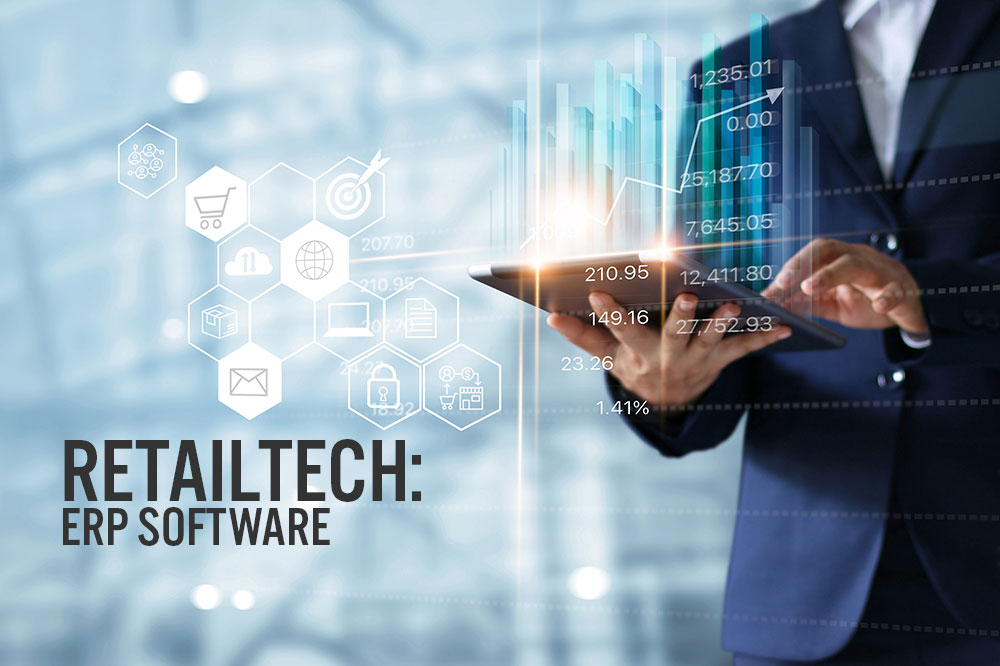
DIpil Das
Introduction
The concept of ERP software emerged in the 1990s from beneath the bland umbrella of businesses management software and gained steam as enterprises rushed to modernize IT systems to prevent them from malfunctioning for fear of malfunctions due to the looming millennium bug/Y2K event, as well as due to rising levels of global competitiveness, controls and reports required to comply with the US Sarbanes-Oxley Act of 2002. From its humble origins in manufacturing, ERP software has over the years gained functionality in accounting and finance, since costing and financial analysis are interwoven with production. It then added other business functions, including accounting, finance, HR, inventory planning, supply chain and business intelligence. Now, ERP serves as the nervous system for modern enterprises, in particular, retailers requiring online and offline businesses, demand and inventory forecasting, and customer data to be connected to operate efficiently and intelligently. Increasing competition from e-commerce and changing consumer demands make ERP software essential for retailers. It functions as the central nervous system of a modern multichannel business, tying together commerce, inventory, warehousing, fulfillment and analytics. Leading-edge ERP solutions also include AI/machine learning tools, and the platforms offer an environment for users to write their own apps to customize functionality. And retail stands to benefit greatly from ERP software, as software vendors deepen the functionality with customized functions and modules especially within industry verticals, particularly retail. This report continues our RetailTech series, covering major technologies and themes in retail technology.Overview of ERP Software
ERP software falls within the scope of business-management software: The term was coined in the early 1990s and has evolved from coordinating resources for manufacturing to add financial, HR and other functions. ERP software also became necessary as enterprises were required to institute financial and operational controls following the US Sarbanes-Oxley Act of 2002, which was instituted to improve financial disclosure and prevent accounting fraud, following huge accounting scandals such as those at Enron and WorldCom. Common functions of ERP software are illustrated in the figure below. [caption id="attachment_98386" align="aligncenter" width="700"]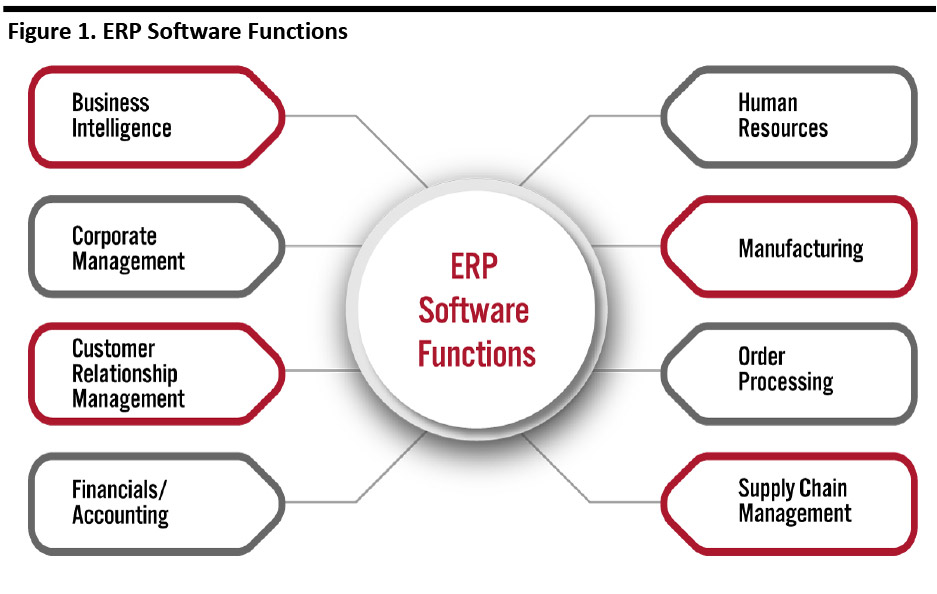 Source: Coresight Research[/caption]
ERP platform functions include:
Source: Coresight Research[/caption]
ERP platform functions include:
- Business intelligence: reporting, analytics and forecasting.
- Corporate management: performance and governance.
- Customer relationship management: sales and marketing, customer information and service.
- Financials/accounting: budgeting, cost management, ledgers, fixed assets, payables and receivables.
- Human resources: recruiting, training, payroll, benefits and offboarding.
- Manufacturing: production, workflow, quality, process and product lifecycle.
- Order processing: credit verification, inventory, shipping, sales reporting.
- Supply chain management: suppliers, inventory, warehousing.
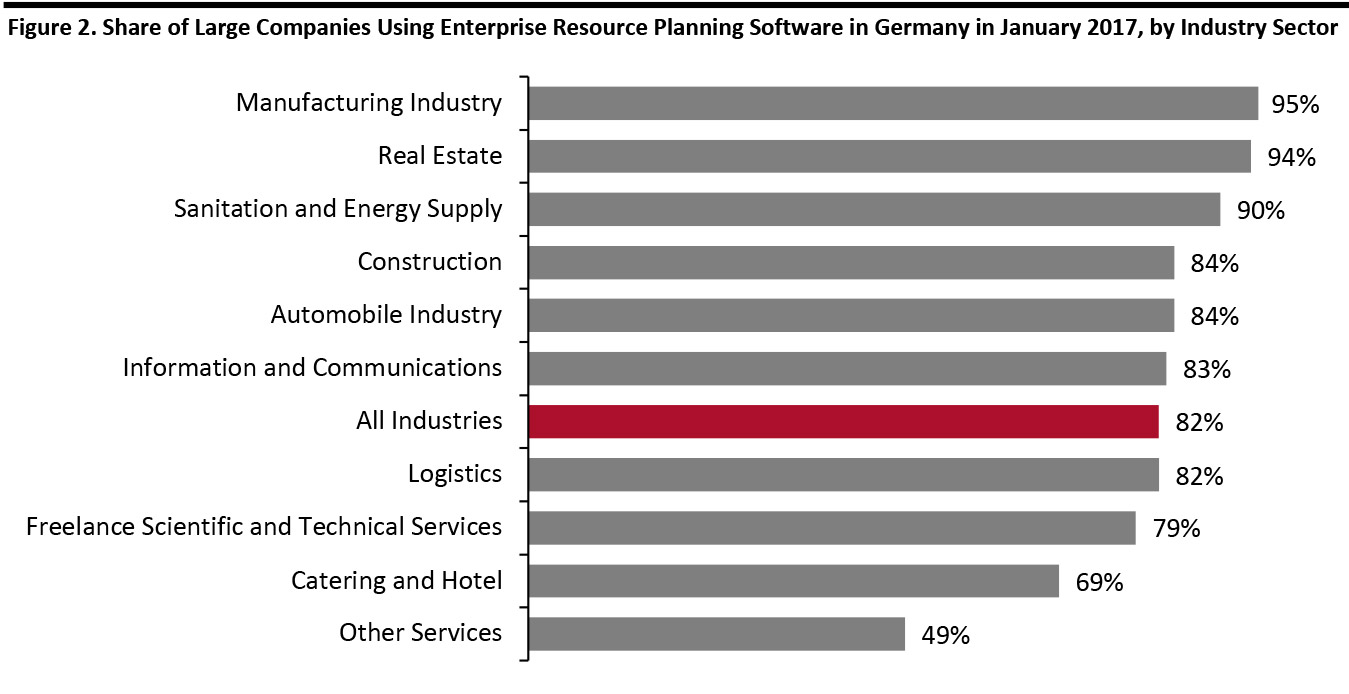 Source: Statistisches Bundesamt[/caption]
In the neighboring Netherlands, the ERP penetration rate in wholesale and retail was 92.1% in early 2019, according to Smart Profile.
ERP Technology
An ERP platform leverages database software, which can run on the client’s hardware or in the cloud. Running on top of the platform are the user’s own applications and customizations, as depicted in the figure below.
[caption id="attachment_98388" align="aligncenter" width="700"]
Source: Statistisches Bundesamt[/caption]
In the neighboring Netherlands, the ERP penetration rate in wholesale and retail was 92.1% in early 2019, according to Smart Profile.
ERP Technology
An ERP platform leverages database software, which can run on the client’s hardware or in the cloud. Running on top of the platform are the user’s own applications and customizations, as depicted in the figure below.
[caption id="attachment_98388" align="aligncenter" width="700"] Source: SAP/Coresight Research[/caption]
ERP vs. CRM
Although CRM is included as a functional category of ERP software for organizational purposes, due to ERP’s history in manufacturing, CRM evolved as a separate category. However, the interrelatedness of databases, ERP and CRM can be demonstrated by CRM industry leader Marc Benioff’s having worked at Oracle (which was founded by Larry Ellison, who had previously worked at database leader IBM) prior to founding Salesforce.
Traditional ERP software vendors such as SAP, IBM and Microsoft have added CRM functionality, and CRM leader Salesforce recently launched a Manufacturing Cloud, a version of its platform tailored for manufacturers.
The Database: The Foundation for ERP
ERP systems need to track large amounts of information on a large amount of data on manufacturing, finance and business information, and hence need to operate on a database foundation. As these functions are interconnected, many database software leaders (such as Oracle, IBM and Microsoft) are also leaders in ERP software.
The figure below contains a breakdown of the market for relational-database software. Whereas traditional bases store all their data in one large file, modern, relational databases store their data in a collection of smaller, interlinked files.
[caption id="attachment_98389" align="aligncenter" width="700"]
Source: SAP/Coresight Research[/caption]
ERP vs. CRM
Although CRM is included as a functional category of ERP software for organizational purposes, due to ERP’s history in manufacturing, CRM evolved as a separate category. However, the interrelatedness of databases, ERP and CRM can be demonstrated by CRM industry leader Marc Benioff’s having worked at Oracle (which was founded by Larry Ellison, who had previously worked at database leader IBM) prior to founding Salesforce.
Traditional ERP software vendors such as SAP, IBM and Microsoft have added CRM functionality, and CRM leader Salesforce recently launched a Manufacturing Cloud, a version of its platform tailored for manufacturers.
The Database: The Foundation for ERP
ERP systems need to track large amounts of information on a large amount of data on manufacturing, finance and business information, and hence need to operate on a database foundation. As these functions are interconnected, many database software leaders (such as Oracle, IBM and Microsoft) are also leaders in ERP software.
The figure below contains a breakdown of the market for relational-database software. Whereas traditional bases store all their data in one large file, modern, relational databases store their data in a collection of smaller, interlinked files.
[caption id="attachment_98389" align="aligncenter" width="700"]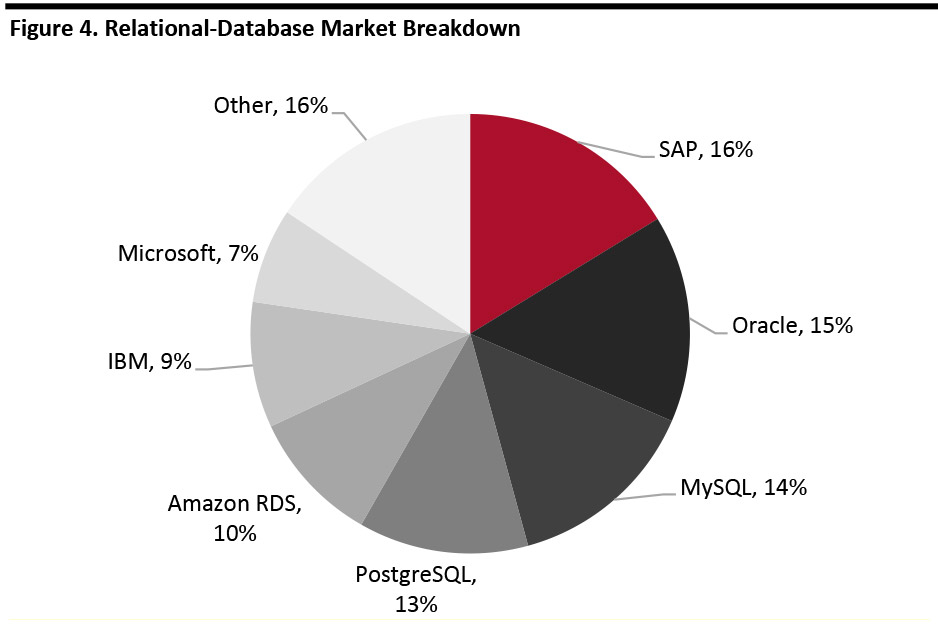 Source: HTF Market Intelligence[/caption]
Into the Cloud
ERP software providers are porting their platforms (and their own operations) to the cloud to accommodate enterprises that are digitalizing and moving their own businesses and data to the cloud.
The graph below shows that all major global regions are in various stages of evaluating and implementing cloud computing, which represents a progression from evaluation to trial to initial implementation to broad implementation. 99% of enterprises surveyed are evaluating moving to the cloud.
[caption id="attachment_98390" align="aligncenter" width="700"]
Source: HTF Market Intelligence[/caption]
Into the Cloud
ERP software providers are porting their platforms (and their own operations) to the cloud to accommodate enterprises that are digitalizing and moving their own businesses and data to the cloud.
The graph below shows that all major global regions are in various stages of evaluating and implementing cloud computing, which represents a progression from evaluation to trial to initial implementation to broad implementation. 99% of enterprises surveyed are evaluating moving to the cloud.
[caption id="attachment_98390" align="aligncenter" width="700"]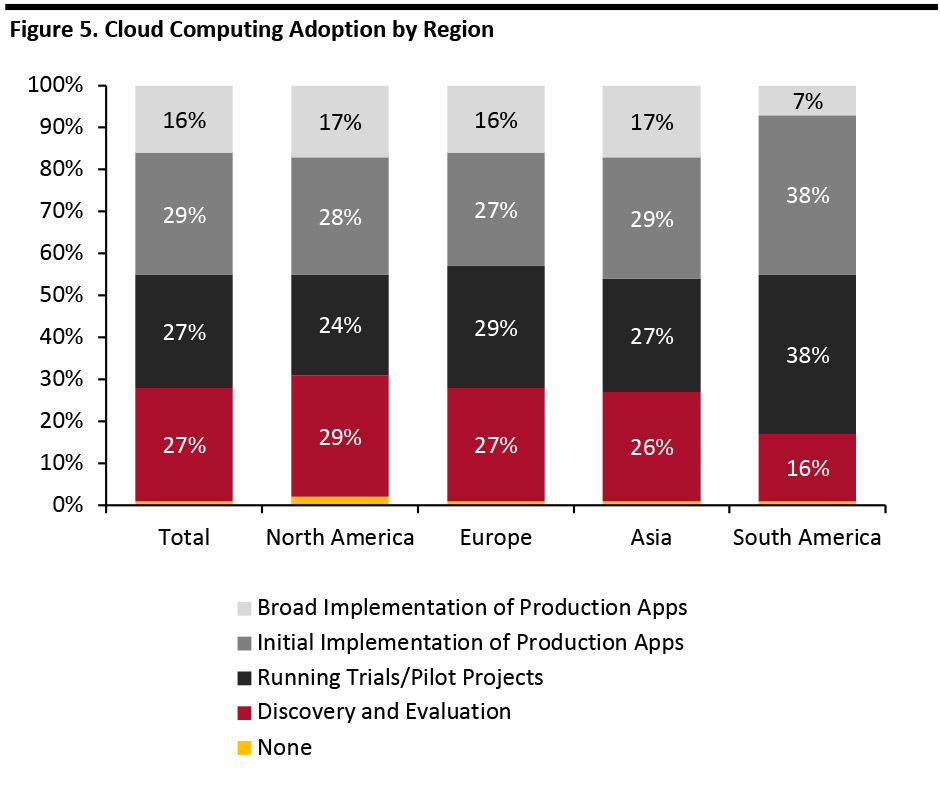 Note: Ranking based on number of mentions of the system on websites, general interest in the system, frequency of technical discussions about the system, number of job offers, number of profiles in professional networks and relevance in social networks.
Note: Ranking based on number of mentions of the system on websites, general interest in the system, frequency of technical discussions about the system, number of job offers, number of profiles in professional networks and relevance in social networks. Source: db-engines.com, October 2019 [/caption] Advances in Cloud Computing The function and features of cloud computing, as with all technology, are constantly evolving. The first phase of cloud computing involved implementing “lift and shift,” i.e., porting data and transferring processing to the cloud. The second phase requires employing different ways of looking at data and designing cloud-based applications. Oracle has coined the term “Gen2 Cloud” for the second generation of cloud computing and defines the generations as follows: · First generation: User code and data are stored on the same computers as the cloud control code with shared central processing unit (CPU), memory, and storage. · Second generation: customer code, data, and resources are stored on a “bare metal computer,” whereas cloud control is stored on a separate computer with a different architecture. In this architecture, the cloud provider does not have access to customer data, and users do not have access to cloud control code. This separation of computer code and data should improve security and could prevent security lapses such as the recent theft of data on 100 million Capital One customers by a former AWS employee.
Implications for Retail
Retailers, like other industries, stand to gain substantial benefits by implementing an ERP platform. In addition to the general benefits from measuring and controlling all businesses processes, ERP benefits include:- Cost reduction: replacing unused, legacy systems.
- Scalability: enables the rapid addition of capabilities.
- Insights and analytics: provides tools to analyze and forecast the business and new opportunities.
- Inventory cost: optimizing inventory and warehouse management to reduce working capital.
- Financial reporting: connecting operations and finance enables real-time financial control and measurement.
- Organizational change: the installation of systems can serve as a tool for organizing and implementing improvements to business processes.
- Omnichannel: coordinates e-commerce, inventory management and fulfillment.
Markets
The global enterprise software application market is forecast at nearly $234 billion in 2019, growing at a 9.2% CAGR through 2022. The US ERP market is estimated at $16.4 billion in 2019, and is projected to grow at a CAGR of 4.2% during 2016-2021, according to Statista. The US CRM market is slightly larger, estimated at $19.0 billion this year and growing at an 8.9% CAGR during the same period, also according to Statista. [caption id="attachment_98391" align="aligncenter" width="700"]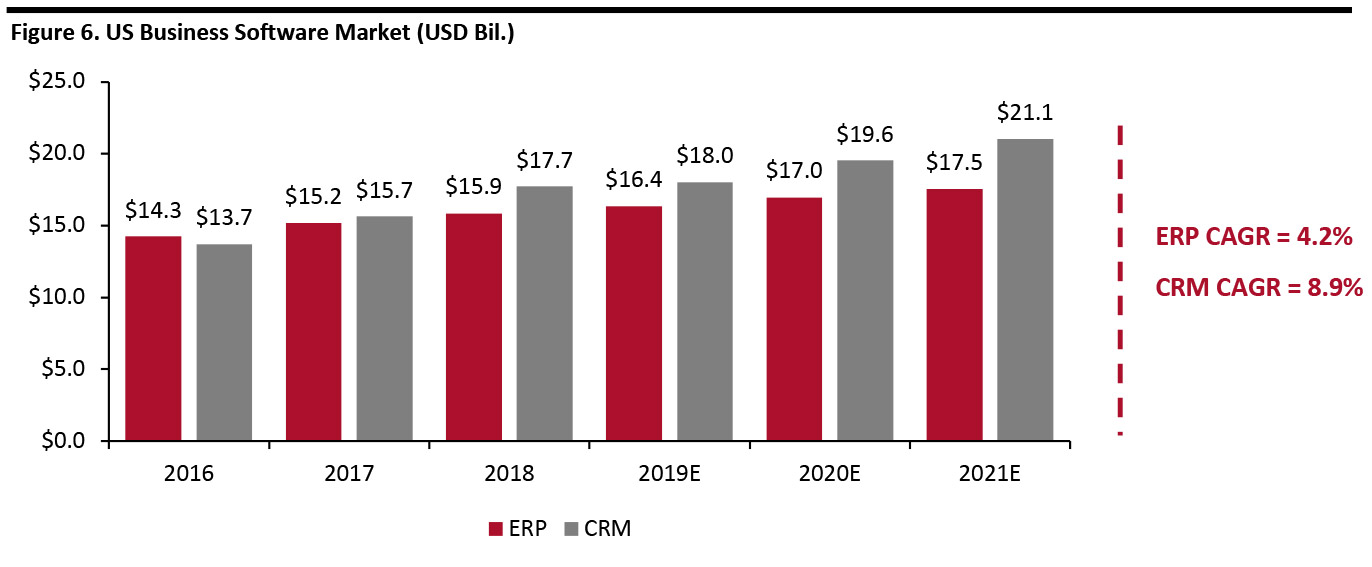 Source: Statista[/caption]
Growth Drivers
The sector experienced rapid growth in the 1990s as companies rushed to modernize systems to avoid the feared year-2000 bug and to account for the introduction of the euro. Owing to its 30-year history, ERP software is a mature market.
Despite this maturity, many ERP software vendors are seeing a revenue lift from enterprises moving to the cloud and adding CRM capabilities. For example, in its most recent quarter, SAP saw 10.7% total revenue growth, driven by 40% growth in Qualtrics experience-management revenue. The company expects 33-39% growth in adjusted cloud revenue in 2019.
The figure below breaks down the global ERP market, featuring the top 10 vendors in 2017.
[caption id="attachment_98392" align="aligncenter" width="700"]
Source: Statista[/caption]
Growth Drivers
The sector experienced rapid growth in the 1990s as companies rushed to modernize systems to avoid the feared year-2000 bug and to account for the introduction of the euro. Owing to its 30-year history, ERP software is a mature market.
Despite this maturity, many ERP software vendors are seeing a revenue lift from enterprises moving to the cloud and adding CRM capabilities. For example, in its most recent quarter, SAP saw 10.7% total revenue growth, driven by 40% growth in Qualtrics experience-management revenue. The company expects 33-39% growth in adjusted cloud revenue in 2019.
The figure below breaks down the global ERP market, featuring the top 10 vendors in 2017.
[caption id="attachment_98392" align="aligncenter" width="700"]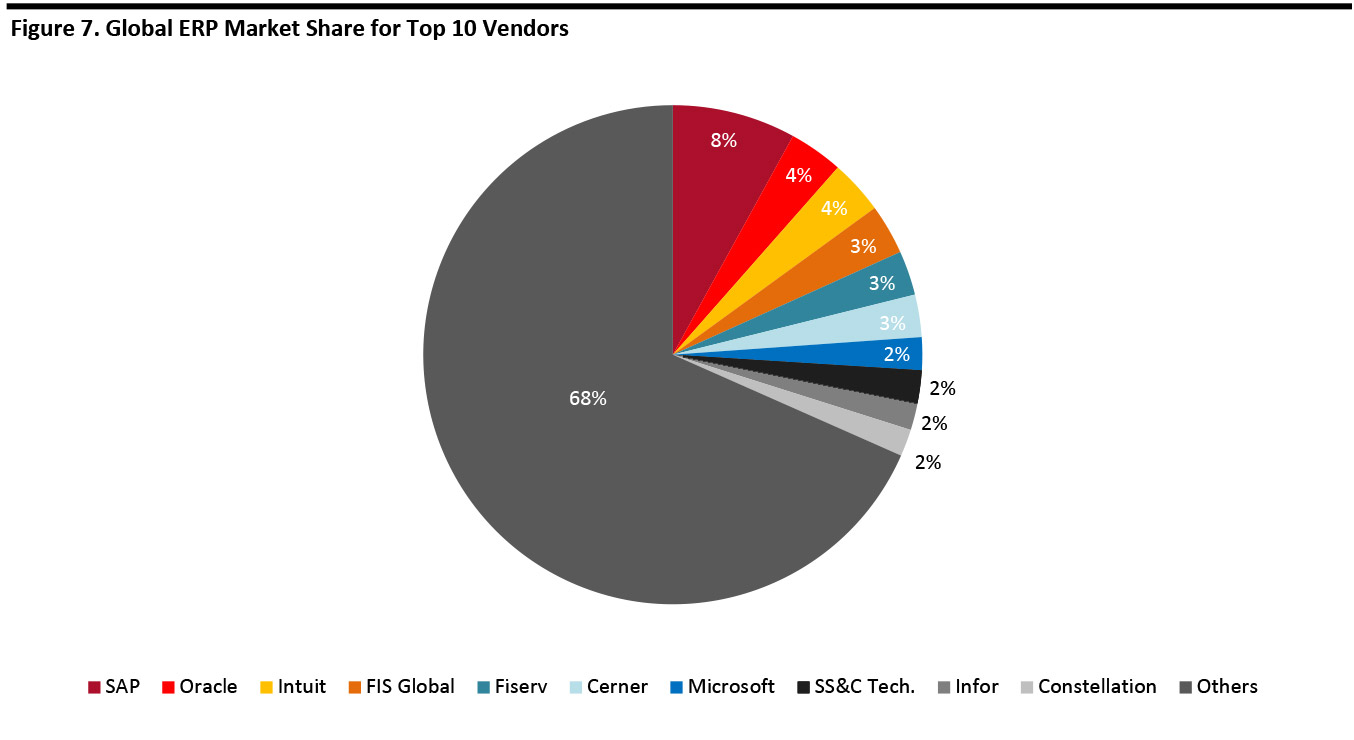 Source: Apps Run the World[/caption]
Source: Apps Run the World[/caption]
ERP Companies
ERP providers under Coresight RetailTech 20 research coverage include:- Infor: Offers its CloudSuite platform, which includes Infor LN ERP solution, M3 for manufacturing and distribution and CloudSuite Financials.
- Microsoft: Its Dynamics 365 software offers applications for sales, service, marketing, finance and operations, HR, AI and managing digital content.
- Oracle: The company’s ERP Cloud offers a broad array of functions, including accounting, financials, procurement, project management, risk management, enterprise performance management, supply-chain management, AI apps and NetSuite (for small and medium-sized businesses).
- Salesforce: Expanding from its leadership in CRM, the Salesforce platform has embraced many ERP-like functions, including sales, commerce, apps, analytics and has developed solutions for specific industries, including its Manufacturing Cloud, which it launched in September 2019.
- SAP: ERP product offerings include SAP S/4 HANA (in regular and cloud versions), Cloud ERP, as well as other categories such as HR and people management, CRM and customer experience, digital supply chain and intelligent technologies.
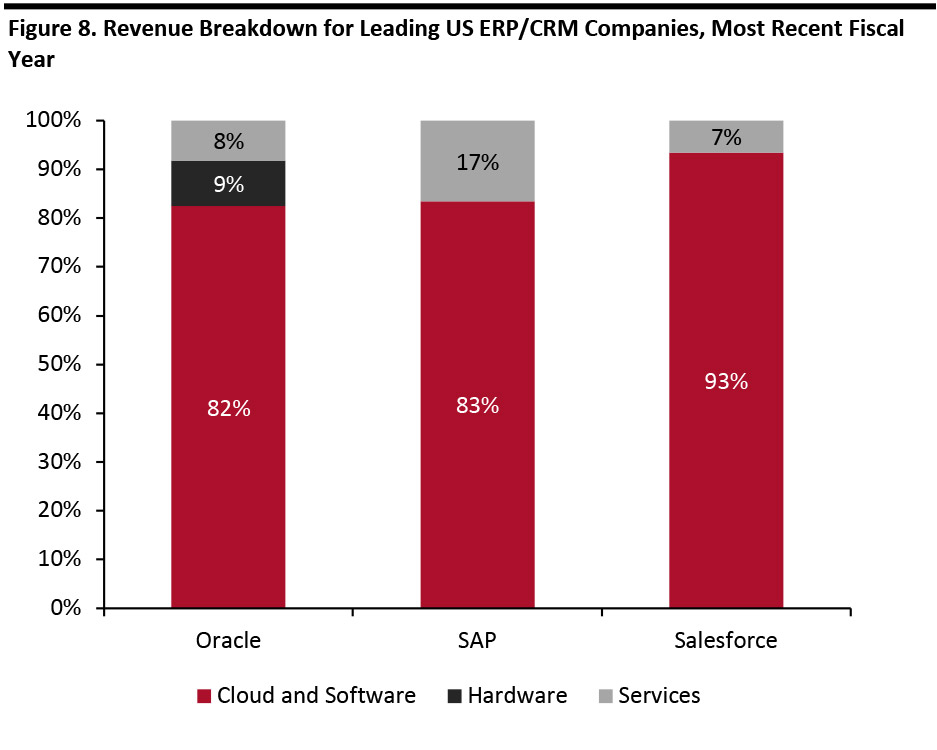 Source: Company reports[/caption]
Oracle’s revenue mix differs from that of other large ERP software vendors, with 9% of its revenues deriving from hardware sales. Its hardware offerings include Oracle Engineered Systems, servers, storage and industry-specific products, among others. In 2009 Oracle acquired Sun Microsystems, workstation manufacturer and developer of the Java programming language, and also offers Exadata, a high-performance dedicated hardware-software device that runs Oracle’s database software.
Source: Company reports[/caption]
Oracle’s revenue mix differs from that of other large ERP software vendors, with 9% of its revenues deriving from hardware sales. Its hardware offerings include Oracle Engineered Systems, servers, storage and industry-specific products, among others. In 2009 Oracle acquired Sun Microsystems, workstation manufacturer and developer of the Java programming language, and also offers Exadata, a high-performance dedicated hardware-software device that runs Oracle’s database software.